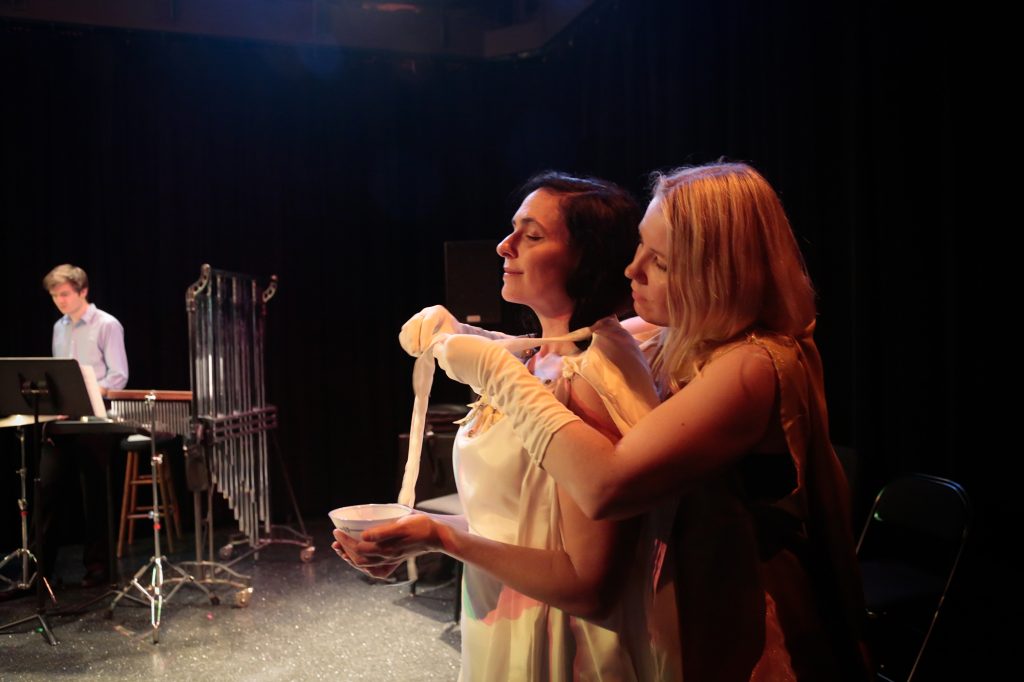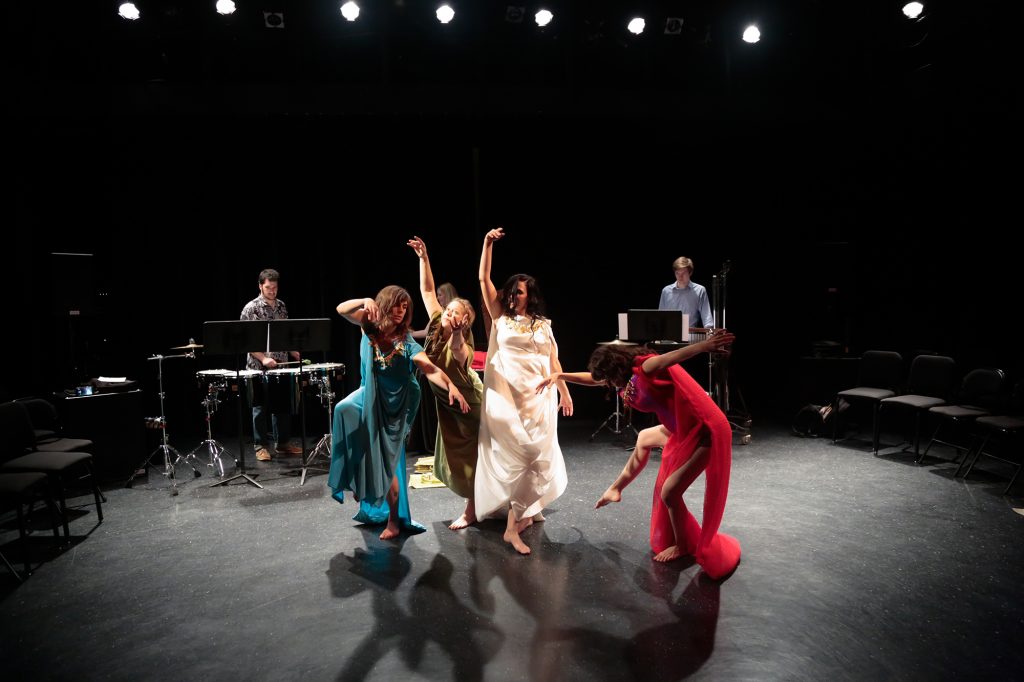Andrea Trombetta
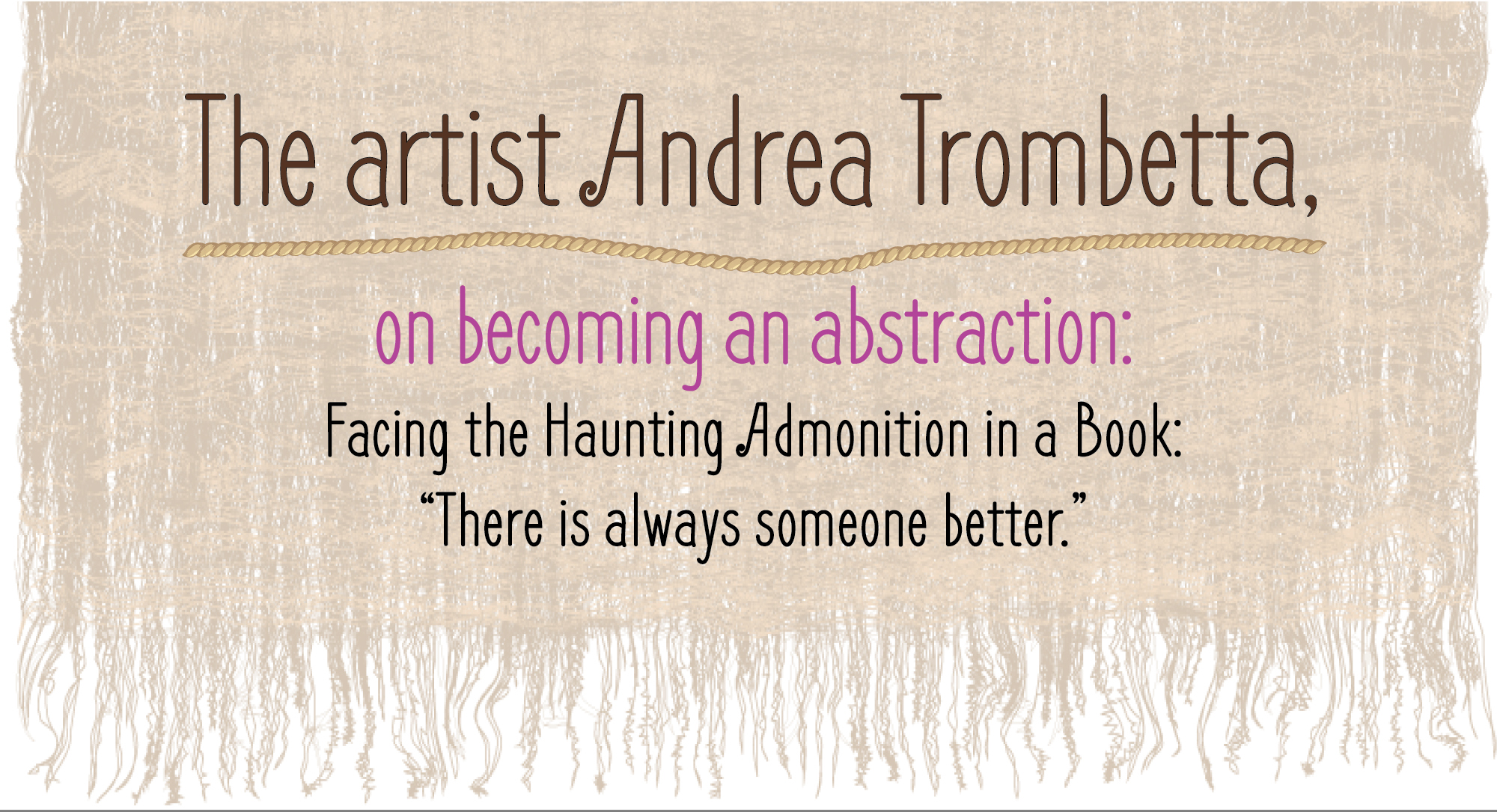
By: Cynthia Adams | Photos By: Nancy Evelyn
Andrea Trombetta, a performing and conceptual artist and Lamar Dodd School of Art lecturer grabbed a cappuccino and slipped into a chair at the Ike and Jane café at the Georgia Museum.
She smoothed her dark hair as she returned greetings from art students and passersby. As she discussed how collaborating with PhD candidate Hanna Lisa Stefansson for a dissertation performance had swiftly become a career highlight, Trombetta was seated not so far from the spot her own MFA exit show had occurred only years earlier. Trombetta received her MFA in fabric design at the Lamar Dodd School of Art at UGA in 2005. Since then, she has taught art courses at UGA and at the University of North Georgia and Oglethorpe University.
Textiles continued to be a cornerstone of her work. In the performance with Stefansson, Trombetta would incorporate a fiber optic material, one which could glow like a blue ember.
The performance themes, fire and ice, were vividly illustrated by reds and blues.
The cloth, itself, was so unique that Trombetta had sourced the fabric and ordered it from France. It was, as she explained, orchestrated to be transformative as well as illuminative. Having designed fabric herself, it was thrilling to use such an of-the-moment innovation that owed much to technology.
“The fabric is actually made into a shawl with a battery pack on either end,” Trombetta explained. It was the same high-tech fabric used in a Zac Posen design, one which Claire Danes wore to a Met Gala in New York. Of course, it was also symbolic.
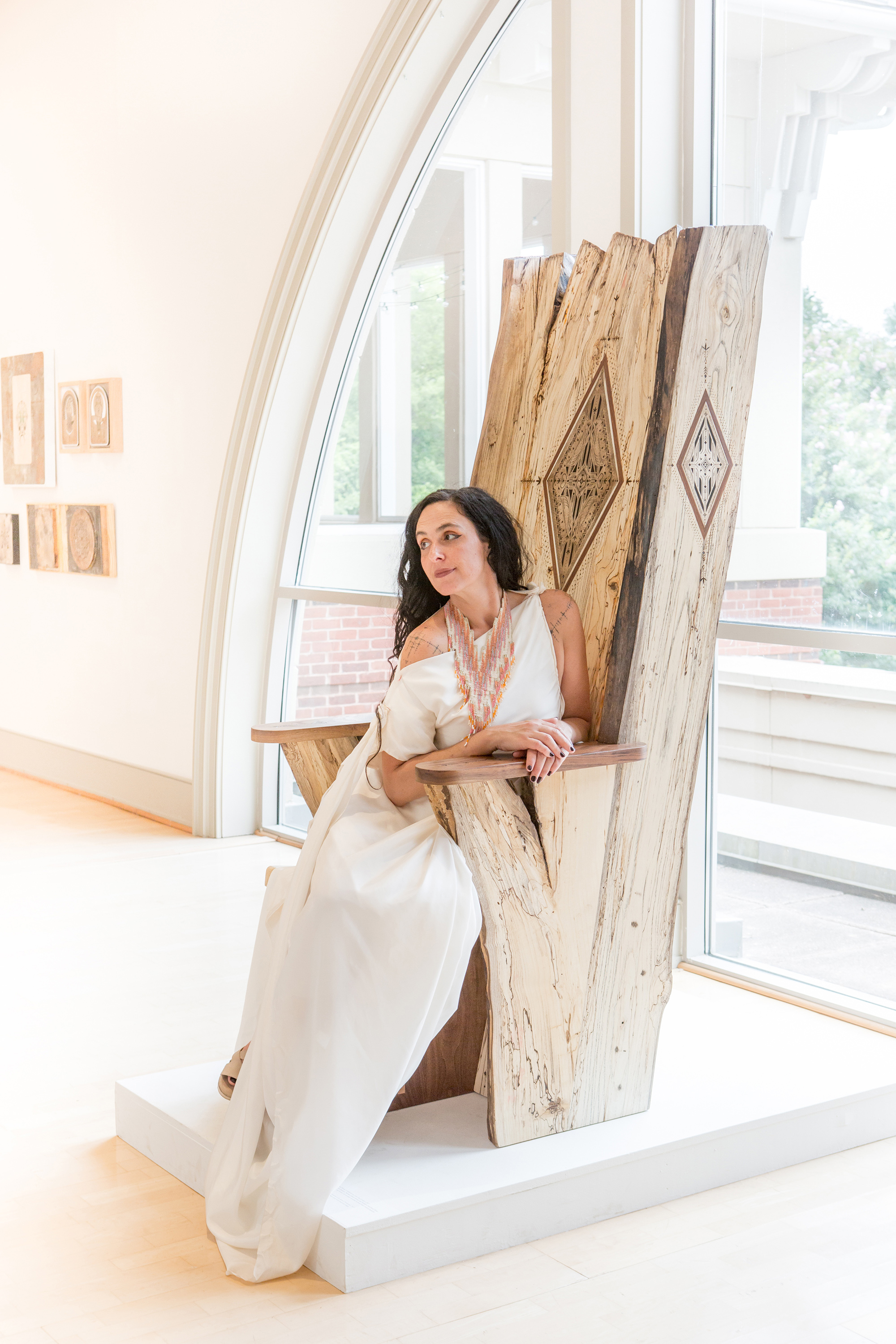
“Ritual Habit”
Normally, such a costume enhancement would have been prohibitive in cost. But Stefansson and Trombetta received grant funding from ICE (an acronym for Ideas For Creative Exploration) in support of Stefansson’s doctoral performance, which was titled “Ritual Habit.” ICE provides support for interdisciplinary initiatives for advanced research in the arts.
Part of the ICE grant was applied to acquiring the fiber optic fabric. The other was used for audio equipment to be used by Stefansson, a composer and musician profiled last year within this magazine. According to Stefansson, “half of the grant money was used for an audio interface, for colloid outputs. The other half went to purchasing the fiber optic fabric.”
In Stefansson’s words, the glowing fabric would contribute to a “climactic moment.”
Trombetta was also part of choreographing the performance which involved dancers, three percussionists, and a flute player, all staged in a black box theater. The performance would take place the night after the interview, and Trombetta herself had become an integral component.
As she explained it, the experience of their corroborative preparations was filled with serendipitous overlaps. Trombetta regarded this as important to the process of artistic discovery and to the performance itself—which was organic and unfolding, like life itself.
And for Trombetta, someone with an introspective bent, she considered the big themes of life and took coincidence seriously. But on that particular April morning, she felt a bit more thoughtful than normal. With her eyes wide and serious, she said she has been thinking a great deal in particular about death.
She had a birthday pending. It was merely two days away. A month after the performance, Trombetta emailed: “I think the recent loss of my stepfather in January and then my cat of 18 years and two weeks, played a major role in my momentum during ‘Ritual Habit.’ Upon my stepfather’s death, halfway through our collaboration, I wasn’t sure if the grief would enable me to continue with the project. Instead, I chose to honor his last breath as well as my kitty’s, and feed the emotions and inevitable transitions of life and death into the piece.”
This had prompted much self-examination, she said. For artists, everything in the immediate and past field of experiences becomes raw creative material to be synthesized, used, and, ultimately, translated.
No doubt, this introspection would feed her role in Stefansson’s event the following night. At the thought of this, she took a deep sip of coffee.
Trombetta’s work, largely improvisational, improvises within a choreographed framework. “There is a structure to improvisation” she explained. Her water series, incorporating fabric and dance, were large-scale, temporal pieces that called to mind the work of artist Christo.
In the course of her own performances, Trombetta created haunting temporary, site-specific works which were captured in photographs. Titled “Sea of Japan,” these were also done during a time of loss, as she was losing her dog, Bali. It was elegiac work with the artist herself the subject. In The Water Dress Series, Trombetta was photographed underwater, while the diaphanous folds of fabric moved about her, liquid and serene. The piece concerned her recovery following a traumatic accident, one which changed the trajectory of her life.
“I had been in a car accident, hit head on in front of Foundry Park Inn.” She describes how the accident occurred on a momentous date. “On my first day of grad school—and I had to go to ancient art history with Frances Van Keuren.”
Following the accident, Trombetta could not even touch her own toes. The artistic works she later produced became a larger series prompted by her journey through physical trauma. The Water Dress Series was born of this period.
“It was a healing series,” Trombetta observed. “I became enamored of the feeling of how water was healing, while doing therapy. It was so beautiful. That was later part of my thesis exhibition, a wall of fabrics and dresses…and me, (appearing,) yet never (showing) my face.”
Self-portrait was an accessible and objectifying tool for an artist. “That is my agenda, so people are looking at my work, seeing woman.” She became an abstraction. The photographs Trombetta composes, creates, and often appears in, are dream-like, floating and representational. “I have to set my intentions to accept whatever happens,” she added.
And so Trombetta became a conceptual artist while still in graduate school, as life presented the raw material of her working themes. She also was practical. “I went straight into performance while making art for sale.”
She discussed art and commerce, finding that teaching meant also preparing students for a range of future possibilities. Trombetta keeps her hand in the field of fabric design, although performance art remains the thrust of her work.
“I’m also teaching material futures, which is in the fabric design department. You want to design for Target, for Anthropologie? You can, but first can you be original? Can you produce works of art that are innovative and that no one’s seen before? You must be creative. The art comes first.”
She describes the native talent and self-confidence required for art. “It has been an incredible practice to teach to non-art majors and then in a studio, presenting yourself in a very competitive arena. How to nurture artists so they can create original work…? I want to give them the skill sets, the vigor.”
- “Ritual Habit,” the April 9th performance, is captured in the following still shots.
- To view the 37-minute performance, visit: https://www.youtube.com/watch?v=XyT4-qA1Hhc
Finding an Artistic Home in Athens
Trombetta, who was born in Chicago, came to UGA for both undergraduate and MFA degrees. She received her BA in studio art from the Lamar Dodd School of Art before later returning to enter the MFA program. Completing a full experiential circle, the student became teacher. She continues her performance art and teaches art courses where her studies were begun.
With entry level survey courses, there was the matter of how to engage the student who knows little on a subject, while captivating those who know more. The balancing of this is a bit more complex when the student roster numbers in the hundreds.
“Art appreciation is so unique as compared to studio courses—you will have one or two who have studied art history, or taken art classes in high school or have family who are artists,” Trombetta explained. “But I love it, because I can be accessible to people who are going to walk past color field painting or even three-dimensional designs and not think twice about it. It makes it so worth it, to perhaps influence one or two.”
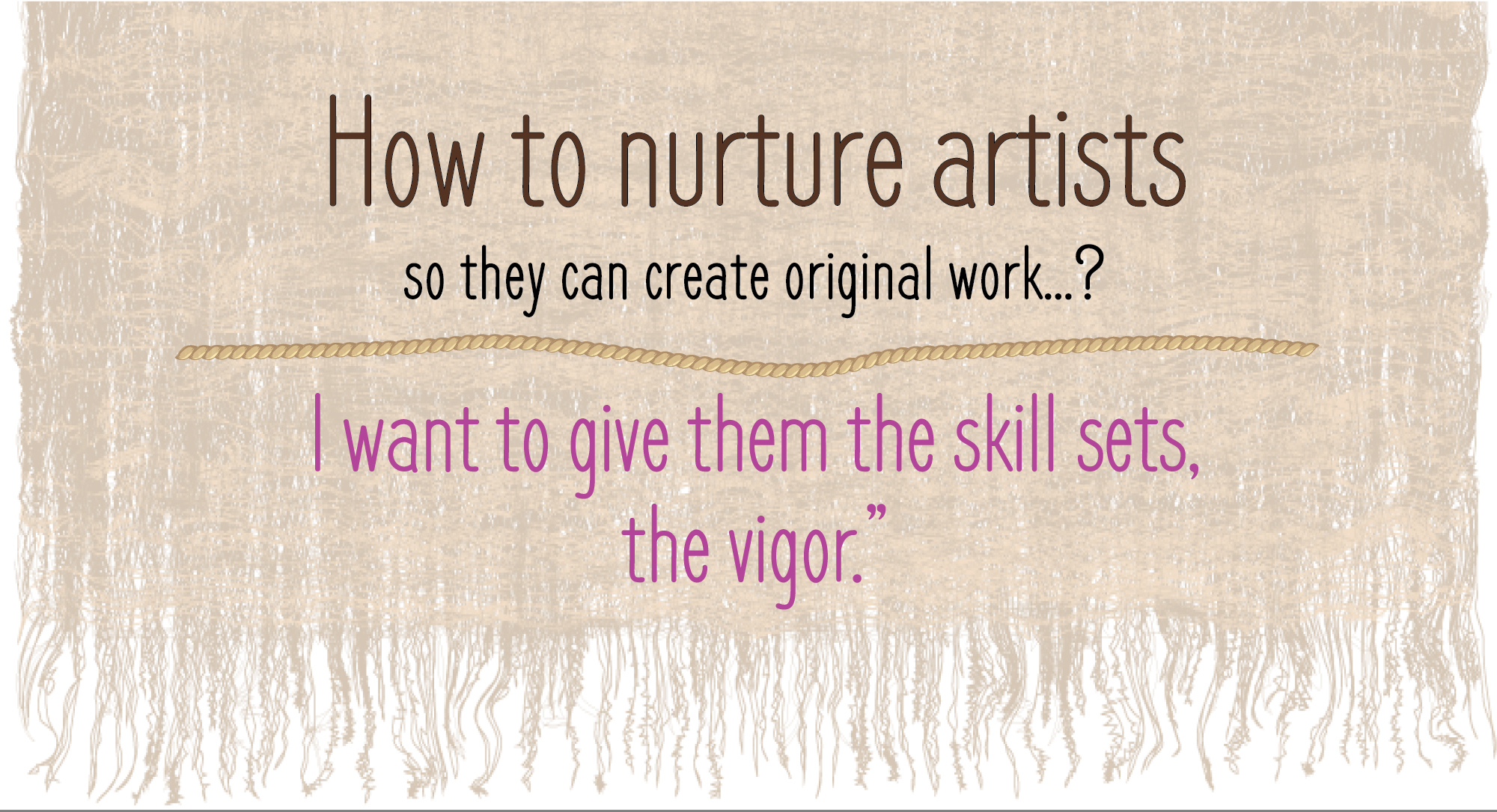
She described being of Italian descent and a single mother rearing a young daughter, Isabella. She speaks Italian “un po’” meaning a little. When her baby was six months old, she took her to Italy in order to hear melodic Italian spoken in its natural setting. “People would say Bella, Bella, and she (Isabella) would look and smile. They would say, ‘oh, your baby loves me!’” And Trombetta chortled, breaking into smiles at the memory.
Ironically, her biggest fears had formerly been childbirth and snakes.
“But I’ve looked death in the eye,” she said.
“I do want to face the world. Making art, raising my daughter. We could go to France, to Italy,” Trombetta mused. “Not to limit myself to one thing.” And, reminding herself of her admonition to her own students, Trombetta added, “To have the vigor!”
So it was a happy coincidence that the recital with Stefansson fell on April 8, which was Isabella’s birthday. Her mother was coming to see the performance and share in a weekend of celebration. Then she related a story. Someone once gave Trombetta an astrological book, and when she turned to the page for her own birthdate, April 9, there was a striking heading.
“’There is always someone better,’ was the quote for Aries,” Trombetta said. The quote was unsettling. After all, this was universally an artist’s first worry: never good enough.
Trombetta sighed. Her father was born April 2, which was her own original due date. Yet Trombetta’s birth occurred a full week later. “The time our time of first breath; there’s something about that…those stars show up every night, don’t they?” Trombetta asked. Her eyes twinkled at the question.
On April 9th, forty years later, the performer would search out her mother, daughter, and good friends in the audience as Stefansson’s doctoral performance began.
The fiber optic shawl glowed brightly; yet, there was no brighter star in the firmament than those on the stage.
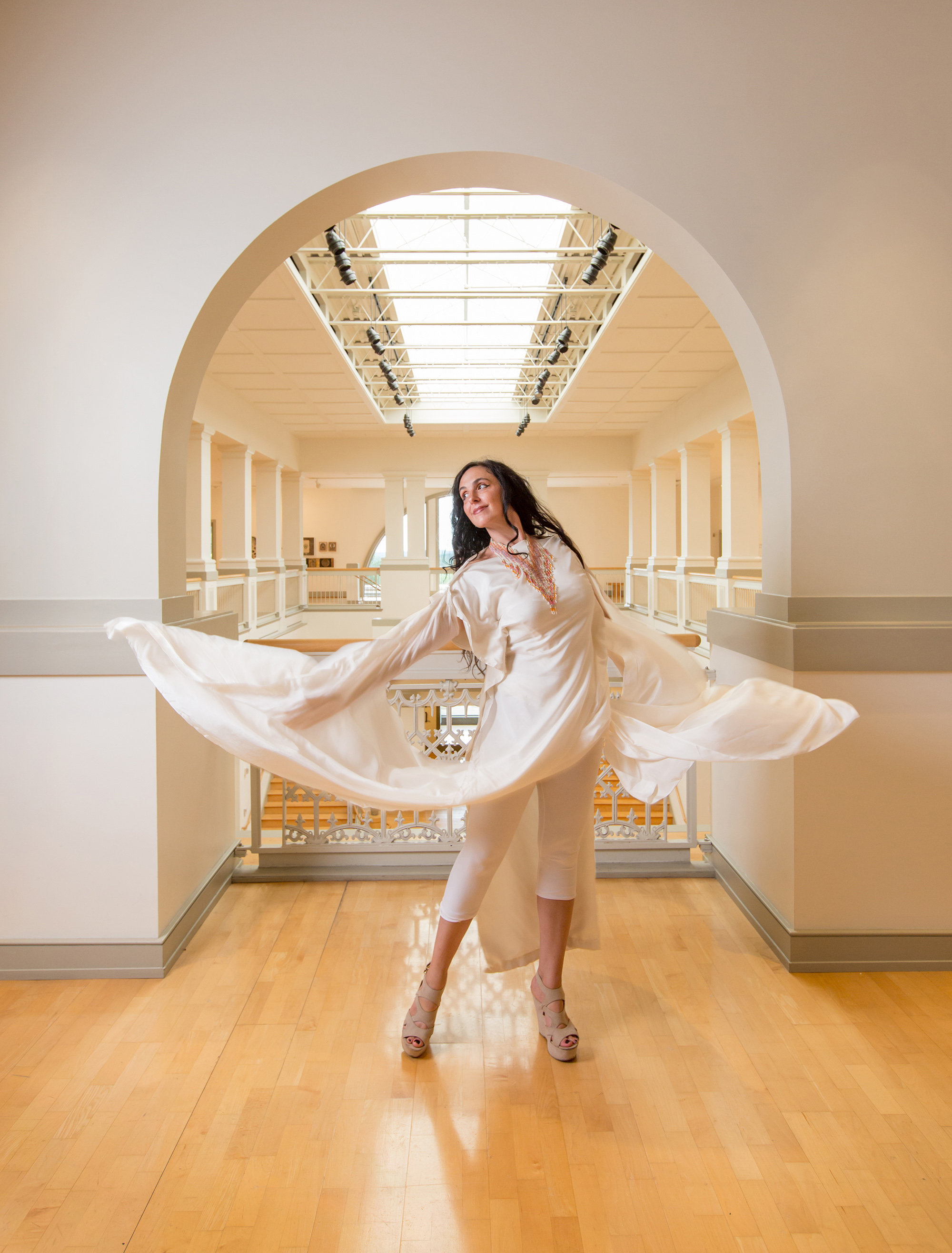
“Ritual Habit,” University of Georgia Master of Fine Arts Exit Show (April 9, 2017)




